The Gift of South Dakota
Subscriptions to South Dakota Magazine make great gifts!
Subscribe today — 1 year (6 issues) is just $29!
Murdo’s 1880 Town
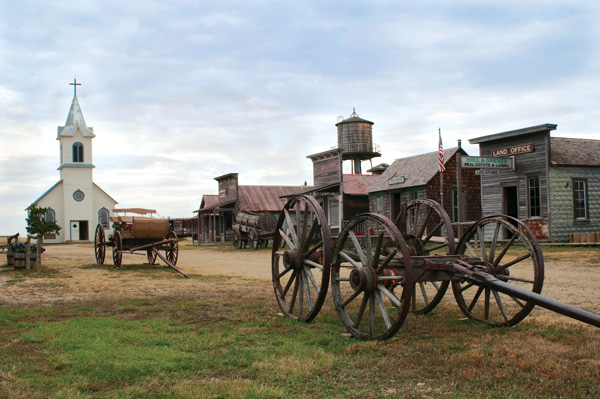 |
| Movie producers started an Old West main street on Clarence Hullinger's land in the 1970s. The movie failed, but today the 1880 Town is a blockbuster. |
Lots of us have attics crammed full of objects that outlived their usefulness — or at least their original usefulness. We don’t discard the stuff because we’ve learned it gains another function: serving as a tangible link to our past.
Located 22 miles west of Murdo on I-90, 1880 Town is South Dakota’s attic. It’s not a crammed attic, though, thanks to its setting on the vast prairie. You gaze down Main Street to the horizon beyond, not to adjacent neighborhoods and tall fast food signs. Much of the stuff here is big: whole buildings hauled in from Quinn, Dixon, Tea, Gregory, Gettysburg, and countless other living or forgotten towns, including long-submerged Oahe Mission (under Lake Oahe).
So while the town site isn’t authentic to history, its structures are. That sets it apart from most other recreated Old West towns. You feel the authenticity in weathered wood textures, and you smell it. “These buildings stood through the big dust storms of the 1930s,” observes the town’s only year-round resident, Scott Key. “You’re probably still smelling some of that dust.”
“Visitors tell us they feel like they actually walked back in time,” says Richard Hullinger, the attraction’s co-owner. “They often add that they didn’t necessarily expect that when they stopped.”
1880 Town didn’t originate with any grand vision of authenticity. In the early 1970s a movie production company made a deal with Murdo’s Clarence Hullinger. He would supply antiques for a western scheduled to be shot in South Dakota, and the company would build an Old West main street on Hullinger family property. In the end the movie shoot fell through, but an ersatz saloon and little shop were left behind as reminders of the project, standing within view of spanking new I-90.
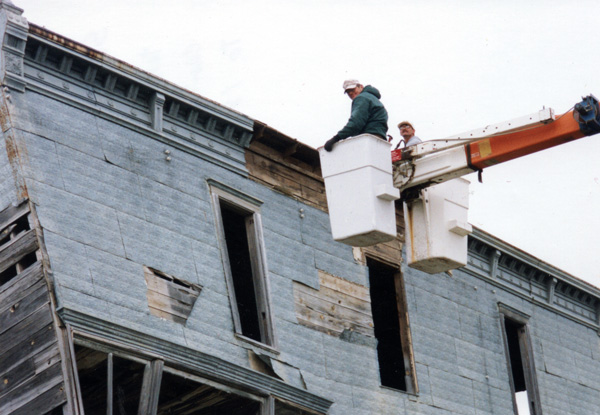 |
| Scott Key, right, takes apart the Carter saloon piece by piece. |
In Murdo people say plans for expanding the site, first called Two Strike after the historical Lakota leader, were sketched on restaurant napkins. That’s because Clarence and his wife, Anna Marie, owned and operated the local Teepee restaurant. And anyone who knew Clarence could have predicted the town’s expansion wasn’t going to involve construction of phony buildings as long as there were antique structures plentiful across the prairie, standing abandoned on main streets, or relegated to second lives as ranch granaries. Clarence, his granddaughter Sally Cuny says, “always has some sort of antique to show you, along with documentation, whether it’s a gun, picture, or saddle.”
Of course, bringing home a just-purchased gun or saddle is simple compared to a blacksmith shop or railroad depot. Fortunately Clarence had a partner in the venture as enthusiastic as himself: son Richard, who is Sally’s dad.
“Both of them like to have something big to work on,” says Sally. “They get excited about new ideas. For them 1880 Town has been a work in progress for more than 35 years.”
And a great business success. In 1972 Clarence and Richard committed to recreating a prairie town as it might have looked between the years 1880 and 1920. The same year Richard further developed the adjacent interstate exit by opening a service station. In 1974 the New York Times featured the fledgling attraction in a story about traveling cross-country via I-90. Today, with just Scott Key living there full time, 1880 Town draws more visitors per capita than any other South Dakota town.
Scott is an employee who, since 1979, has worn a lot of hats — historic interpreter, groundskeeper, builder, and the photographer behind 1880 Town postcards. Most significantly, he’s provided know-how, muscle, and creativity in moving most of the 30-plus historic buildings to the site. For Scott the most memorable relocation was when a two-story structure — which had served Carter as a bank, post office, and doctor’s office — was acquired in 1999. Built in 1915, it had tin siding, which was common in homestead era prairie construction. He took the building apart plank by plank. “That took a month,” Scott recalls. “Putting it back together took a year.” Each piece was photographed, and each photo numbered to guide the reassembly. The process worked so well, Scott says, “that when we put the tin back on, the nail holes matched up.”
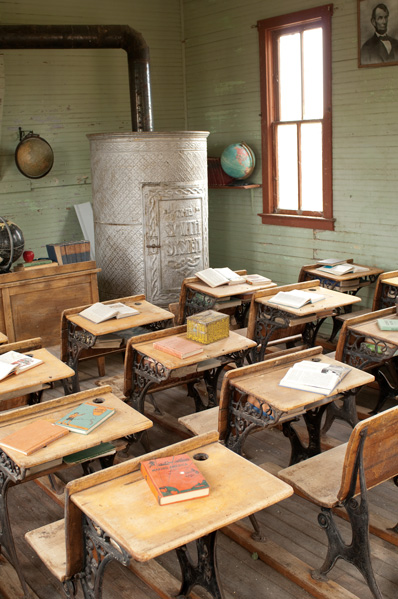 |
| Antique furnishings bring 1880 Town's old-time structures to life. Longtime employee Scott Key combed the region to find the perfect props for each building. |
But it was just a shell of a building with little evidence of the original interior left. That’s where Scott put his creativity to work. He installed a floor from a former church in Quinn, and an ornate pressed tin ceiling from a Winner furniture store and funeral parlor. Voila! 1880 Town’s popular Longhorn Saloon was born.
“People can get a buzz in that saloon,” Scott promises. “Of course, it’s a sugar buzz because we serve sarsaparilla.”
Over the years Scott has scouted the region for smaller antiques, too. One day at a Deadwood auction he learned some movie props were scheduled to be sold at a Rapid City garage sale. So he drove down and bought the props from a film he’d heard about, but hadn’t been released. Scott hit the jackpot. The movie, Dances with Wolves, won the 1991 Academy Award as Best Picture.
Many of those particular props match 1880 Town’s buildings in age. Just months before Scott acquired them, Cindy Costner found them in very much the same way. Kevin Costner’s wife at the time, she drove across South Dakota to auctions, second-hand stores, and old homesteads buying antiques. Their inclusion gave Dances with Wolves a feeling of authenticity.
“People learned we had Dances with Wolves stuff, and they started contacting us about things from the movie they had,” remembers Richard. “So we got more props, including two freight wagons, and we also acquired animals from the movie. The horse Kevin Costner rode, Cisco, lived here until he died last year. The two lead freight mules, Jim and Jake, are still with us.”
Jim and Jake are easy to spot in the movie because the wagon driver calls them just that: Jim and Jake. It’s been 20 years this summer and fall since Dances with Wolves was shot on the South Dakota prairies, and in the badlands and hills. “Still today,” notes Richard, “everything associated with the movie is quite a draw.”
Richard is proud, too, of items associated with another big name — Casey Tibbs. The late world champion rodeo cow- boy from Fort Pierre, might have been happy to know that an expensive and beautiful possession of his would eventually find a good home here.
“We’ve got a pistol of his with his name engraved on the handle,” explains Richard. “He lost it in a poker game and we have a letter documenting exactly how he lost it.”
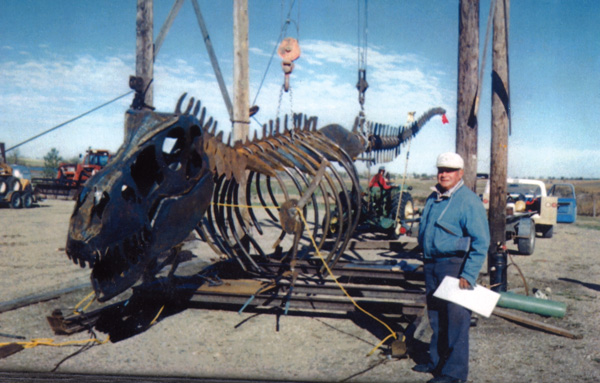 |
| Clarence Hullinger crafted a life size T-rex skeleton from scrap metal in 2002. |
This is an attic, albeit an attic with more emphasis on documentation than most of us consider for our stuff. There’s Draper’s old hotel built in 1910, Gettysburg’s rail- road depot from 1886, and Dixon’s 1915 St. Stephen’s Church. For Sally, growing up, 1880 Town was the most incredible playground imaginable. “And now I’m seeing the same thing in my own three daughters,” she adds. Sally got her first taste of employment here in the 1990s, and she watched a sister and other relatives get married on site. “It’s been a huge part of our family’s life,” she says — for four generations.
The movie that started it all wasn’t to be, but 1880 Town caught the eye of other filmmakers and media companies over the years. A Buick commercial was filmed there, Gateway snapped still shots for a print project, and a national morning news audience watched the state’s centennial wagon train roll through 1880 Town. The Discovery Channel’s Rediscovering America program used the site, as did the Linn brothers of Rapid City for one of their early movies.
But no matter how beautifully it is photographed — and it certainly lends itself to beautiful photography — this is a place that comes fully alive in person. The feel of prairie sun and wind, sound of birds calling, and those earthy smells are central to the experience. 1880 Town opens its gates to visitors in May and the season runs through October. Not only will Scott Key have lots of visitors but, for a few months, neighbors. Some of 1880 Town’s best employees are older couples, most from out-of-state, who park their RVs at a campground a quarter mile north and settle in for a prairie summer.
Editor’s Note: This story is revised from the March/April 2009 issue of South Dakota Magazine. To order a copy or to subscribe, call (800) 456-5117.

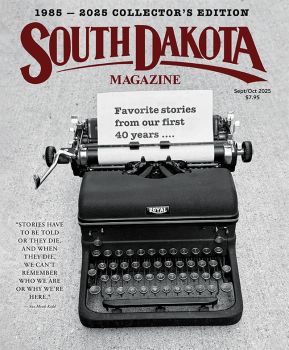
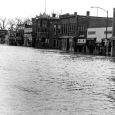
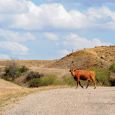
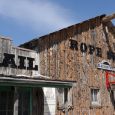
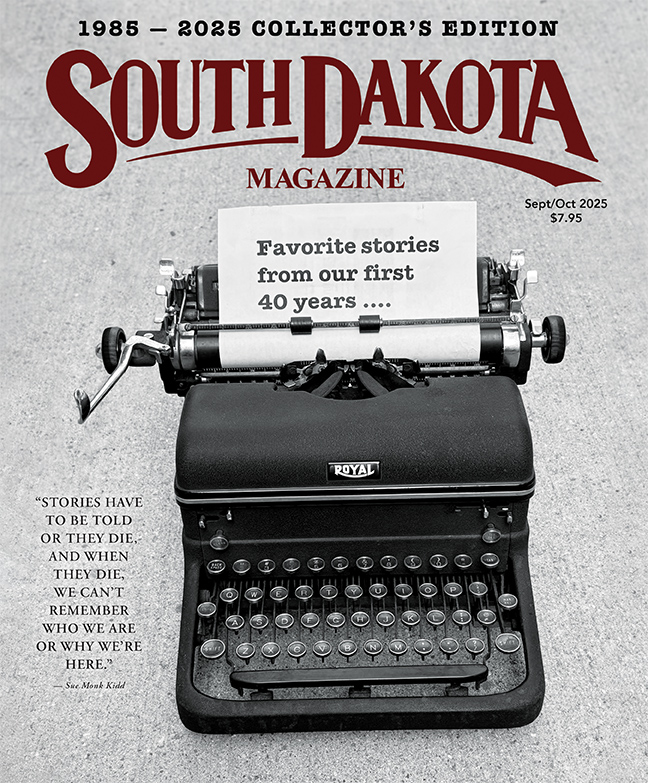

Comments